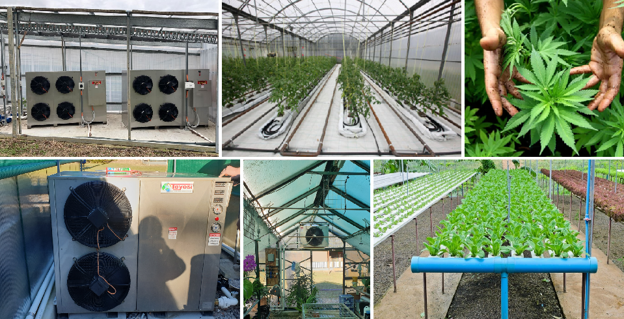Despite the protection a greenhouse offers growers over outdoor farming, managing greenhouse temperatures has been a long-established battle. Greenhouses can quickly overheat during a warm summer and become near freezing over a cold winter.

To combat the temperature war, large gas boilers have been used over winter to provide much-needed warmth and ventilation, and misting or cooling pads have been used to cool the greenhouses over summer. But In Australia and many other parts of the world, there is a growing movement to phase out the reliance on gas-based solutions. This phase-out has left many farmers with a shortfall in their ability to produce greenhouse heating. “Several options to fulfill this gap have been considered, including wood burners, oil or waste oil burners, organic matter, or methane burners, as well as the increased interest in heat pumps,” says Mark Whorlow with Toyesi, a heat pump manufacturer that is for over 30 years in the Australian market. “We already have several greenhouses enjoying using heat pumps for greenhouses hydronic heating, root temperature warming, and hydroponic water temperature control.”
However, he says, most heating solutions lack the ability to provide cooling solutions, thus requiring most greenhouses to rely on multiple solutions throughout the year. “This is where our new climate control systems play a significant role, as they offer numerous benefits for greenhouse operations in both heating and cooling. Giving farmers farm more control over their greenhouses.”
Toyesi’s new Ventura climate control system uses heat pump technology in a standalone air handling system. “It saves costs in equipment and installation due to no requirements for hydronic water pipes, water pumps, and storage tanks. Once you have run the power to the site, they are almost plug-and-play. With 30 to 60 minutes to install each unit, you also save a huge amount on installation costs”, says Mark. They can be standalone or ducted and can be externally controlled via MODBUS 485 Connectivity.
According to Mark, one of the benefits of the Ventura climate control system in greenhouses is their ability to regulate the temperature. “With fluctuating weather conditions outside, maintaining a consistent and optimum temperature is vital for the health of plants. Climate control systems keep the greenhouse cool during hot summers and provide heating during winter, creating a suitable environment for plant growth throughout the year.”
Another advantage of using Ventura climate control systems is improved air circulation and energy efficiency. “Ventura climate control systems are designed with energy efficiency in mind. With advanced technology, they consume less electricity while providing effective cooling or heating. Utilizing energy-efficient climate control systems in greenhouses also helps reduce energy consumption and minimize the overall carbon footprint. Saving more than 50 to 70% of the running costs over a gas-based system.”
Mark says that by controlling the temperature and humidity, the Ventura climate control system enables an all-year-round production opportunity in greenhouses. “This allows growers to extend the growing season by creating an environment that mimics optimal conditions for plant growth or even creating multiple growing seasons. This ensures a consistent supply of fresh produce, increases productivity, reduces the need for imports, and increases export opportunities.”
For more information:
Mark Whorlow
General Manager Sales & Marketing
Toyesi
2/27 Binney Road, Kings Park, NSW 2148
Tel.: (61 2) 9679 9400
Mob.:(61 4) 21 386 320
Fax: (61 2) 9679 9402
Email: [email protected]
www.toyesi.com.au